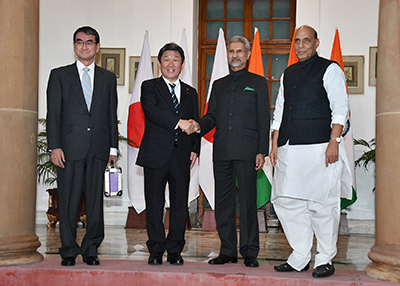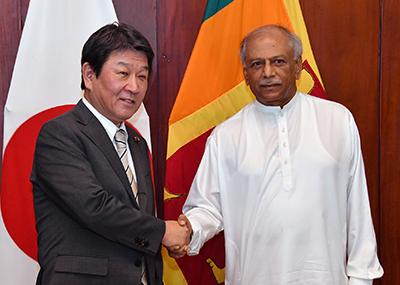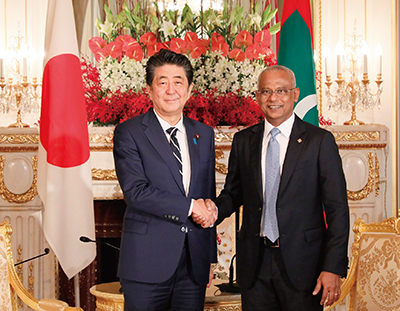Diplomatic Bluebook 2020
Chapter 2
Japan's Foreign Policy that Takes a Panoramic Perspective of the World Map
5 South Asia
(1) India
Geopolitically speaking India is an extremely important country as it faces the Indian Ocean which connects Asia and Africa and is positioned in the center of sea lanes. Moreover, India has the third largest economy in Asia, with the world's second largest population and a huge middle-income group. Japan and India are the two largest democratic countries in Asia, sharing common fundamental values, such as democracy and the rule of law, as well as strategic interests. Recently, India has been implementing a variety of economic initiatives, including “Make in India.” Consumption and production have also been increasing, and foreign direct investment has been rising steadily against a backdrop of deregulation. In diplomatic relations, the “Act East” policy has been laid down in implementing active diplomacy to promote concrete cooperation in the Indo-Pacific region, thereby enabling India to gain more influence in the international arena as a global power.
Regarding relations with Japan, 2019 marked five years since bilateral relations were elevated to the status of a “Special Strategic and Global Partnership.” That same year, Japan-India Summit Meetings were held on the margins of the G20 Osaka Summit in June, the Eastern Economic Forum in Vladivostok, Russia in September, and the ASEAN-related Summit Meeting in Bangkok, Thailand in November. At these meetings, the two countries affirmed their cooperative relations with a view toward achieving a “Free and Open Indo-Pacific.” Moreover, the first Japan-India Foreign and Defence Ministerial Meeting (“2+2” Ministerial Meeting) was held in November, where a frank exchange of opinions was carried out regarding bilateral security and defense cooperation; multilateral cooperation such as Japan-U.S.-India and Japan-U.S.-Australia-India; as well as regional and international situations. In addition, a joint statement was issued, and both sides welcomed the significant progress seen in negotiations toward the conclusion of the Japan-India Acquisition and Cross-Servicing Agreement (ACSA).25 As such moves indicate, numerous concrete accomplishments were achieved in the “2+2” meeting.
 Japan-India Foreign and Defence Ministerial Meeting
Japan-India Foreign and Defence Ministerial Meeting (“2+2” Ministerial Meeting) (November 30, Delhi, India)
- 25 ACSA: Acquisition and Cross-Servicing Agreement
(2) Pakistan
Pakistan is located in a strategic position connecting Asia and the Middle East. Thus, its political stability and economic development are essential for the stability and growth of the region. Pakistan is also one of the most important countries in the context of international counterterrorism measures. Furthermore, the country embraces a population of around 200 million, and approximately 60% of the total population is under 25 years old, thus making its economic potential high. As for internal affairs, in the elections of the National Assembly and Provincial Assembly held in July 2018, the Pakistan Tehreeke-Insaf (PTI), the second largest opposition party, won by a large margin over the ruling party, Pakistan Muslim League-Nawaz (PML-N). The leader of PTI, Khan, was inaugurated as prime minister, and the new Khan administration was launched in August.
In foreign relations, the India-Pakistan relationship has remained tense as a result of the terrorist attack in Indian Kashmir in February 2019 and the subsequent strikes by the air forces of both sides, as well as the Indian Government's decision to revoke Article 370 of the Constitution, which recognized the special status of Jammu and Kashmir. Furthermore, under the “All Weather Strategic Cooperative Partnership,” the relationship with China has been enhanced in a wide range of fields toward the construction of an economic corridor between China and Pakistan (CPEC), which is an important constituent element of China's “Belt and Road” initiative. Regarding the relationship with Afghanistan, there remain many issues to be addressed, including border control and refugee problems. Meanwhile, the relationship with the U.S. remains stagnant with Pakistan being criticized by name in the Trump administration's new South Asia strategy. However, there have been developments on this front, such as a visit to the U.S. by Prime Minister Khan in July 2019.
On the economic front, the growth rates in FY2017/2018 marked around 5.79%, making them the highest in the past 13 years. However, this fell to 3.3% in FY2018/2019. The Khan administration has faced a serious shortage of foreign currency reserves since its inauguration, and it is advancing initiatives to improve this situation through negotiations for support from its friendly countries and the implementation of IMF programs.
Regarding the relationship with Japan, Foreign Minister Makhdoom Shah Mahmood Qureshi visited Japan in April 2019, where both sides exchanged opinions on initiatives to further develop bilateral relations as well as on the regional situation at a foreign ministers' meeting. In addition, President Alvi visited Japan for the Ceremony of the Enthronement of His Majesty the Emperor in October, where he held talks with Prime Minister Abe among other events.
(3) Bangladesh
Bangladesh, in which Muslims account for around 90% of the population, is a democratic country located in the Bay of Bengal and is geopolitically very important as an intersection between India and ASEAN. General elections were held at the end of December in 2018, resulting in the continued rule of the Awami League administration led by Prime Minister Hasina. Furthermore, with the deterioration in peace and order in Rakhine State of Myanmar since August 2017, more than 700,000 displaced persons have flooded into the country, whose acceptance has been placing a growing burden on the local residents. Negotiations have been taking place with the Government of Myanmar to return the refugees, but this has yet to be finalized. On the economic front, the country maintained a steady economic growth rate of around 8.13% in 2019, thanks to robust exports mainly of textile products. With a population of around 160 million people, Bangladesh has a production base with abundant low cost and high-quality labor, and the high potential of its market including considerable infrastructure demand is attracting attention. The number of Japanese-affiliated companies developing business in the country has increased from 61 in 2005 to 305 in 2019. However, the securing of a stable supply of electric power as well as infrastructure improvement remain as challenges for foreign companies investing in the country.
Regarding the relationship with Japan, Prime Minister Hasina visited Japan in May and a Japan-Bangladesh Summit Meeting was held during the visit. In addition, President Hamid visited Japan in October for the Ceremony of the Enthronement of His Majesty the Emperor. From the Japanese side, State Minister for Foreign Affairs Abe visited Bangladesh in February, followed by Minister of Foreign Affairs Kono in July. At the Summit Meeting and Foreign Ministers' Meeting, the two sides affirmed that they would strengthen the bilateral relationship and cooperation on regional and international affairs under the Japan-Bangladesh Comprehensive Partnership. In addition, they held detailed discussions on the response to the issue of displaced persons coming into Bangladesh from Northern Rakhine State of Myanmar.
 Japan-Bangladesh Summit Meeting (May 29, Tokyo; Photo: Cabinet Public Relations Office)
Japan-Bangladesh Summit Meeting (May 29, Tokyo; Photo: Cabinet Public Relations Office)(4) Sri Lanka
Sri Lanka is located in a strategic position on the sea lanes in the Indian Ocean. The country is traditionally one of the friendliest countries to Japan and its geopolitical and economic importance is note-worthy. Regarding domestic affairs, eight locations in the country, including Sri Lanka's largest city of Colombo, were hit by a series of terrorist bombings in April. More than 250 people died (including one Japanese national), and more than 450 people were injured. Regarding politics, President Sirisena, who was elected at the presidential election in January 2015, had managed the Government for five years, but in November 2019, a presidential election was held with the end of his term, and Mr. Gotabaya Rajapaksa of the Sri Lanka Podujana Peramuna was elected as the new president. On the economic front, after the end of the conflict, the economy of Sri Lanka was growing at an annual rate of 7%, and it continues to maintain steady annual growth of over 3% in recent years. Its GDP per-capita was recorded at 4,102 US dollars in 2018, and given the geopolitical importance of the country and its access to the Indian market, an even higher growth rate is expected.
Regarding the relationship with Japan, President Sirisena visited Japan in October 2019 for the Ceremony of the Enthronement of His Majesty the Emperor, marking his third visit since his inauguration. Then in December, Foreign Minister Motegi became the first key official from the Government of Japan to visit Sri Lanka following the establishment of the Rajapaksa administration. There he worked to build a relationship of trust with the new Rajapaksa administration, while holding discussions over matters like cooperation to achieve a “Free and Open Indo-Pacific.”
 Japan-Sri Lanka Foreign Ministers' Meeting
Japan-Sri Lanka Foreign Ministers' Meeting (December 13, Colombo, Sri Lanka)
(5) Nepal
Nepal has geopolitical importance as an inland state between the great powers of China and India. For many years, Japan has been a major donor to Nepal and the two countries keep traditionally friendly relations through a variety of exchanges including between the imperial family and the former royal family, and through mountaineering. In domestic affairs, local elections for the House of Representatives and Provincial Assemblies were held in 2017, and in February 2018, Prime Minister Oli was inaugurated, and the coalition government formed by the Communist Party of Nepal (Unified Marxist-Leninist) (UML) and the Communist Party of Nepal-Maoist Centre (MC) was set up. The UML and MC merged in May and the Nepal Communist Party was established. For many years, Japan has assisted the consolidation of democracy in Nepal, and has been supporting the country's initiative to realize a “Prosperous Nepal, Happy Nepal.” Regarding the relationship with Japan, Foreign Minister Kono visited Nepal in January 2019. During this visit, he paid courtesy calls on President Bidhya Devi Bhandari and Prime Minister KP Sharma Oli. In addition, a Japan-Nepal Foreign Ministers' Meeting was held, where it was announced that Japan would promote assistance to the economic development of Nepal and advance cooperation in the agricultural sector. In October, President Bhandari visited Japan for the Ceremony of the Enthronement of His Majesty the Emperor, where she held talks with Prime Minister Abe for the first time.
In addition, there have been developments toward promoting people-to-people exchanges between Japan and Nepal, such as the resumption of direct flights by Nepal Airlines in August between Osaka and Kathmandu for the first time in 12 years.
(6) Bhutan
In Bhutan, the Tshering administration was launched as a result of the National Assembly election held in October 2018. Bhutan sets Gross National Happiness (GNH) as a guideline of the administration and is currently working on the priority issues of reducing poverty, improving the quality of healthcare and education, gender equality, the preservation of the environment, culture and traditions, stabilization of the macroeconomy, economic diversity, advancing of decentralization, etc., under the 12th Five-Year Plan (from July 2018 until June 2023).
In relations with Japan, King Wangchuck visited Japan for the Ceremony of the Enthronement of His Majesty the Emperor in October. King Wangchuck exchanged opinions with Prime Minister Abe about promoting economic cooperation and people-to-people exchanges.
(7) The Maldives
The Maldives is an island country in the Indian Ocean and its economic growth is mainly led by fishing and tourism, which account for about 30% of GDP. The country's per-capita GDP reached approximately 10,331 US dollars, marking the highest in South Asia. In domestic affairs, the Solih administration was launched in November 2018 as a result of the presidential election held in September 2018. In the parliamentary election held in April 2019, the ruling Maldivian Democratic Party (MDP) captured two-thirds of the seats in parliament, thus solidifying the political footing of the administration of President Solih. Since his inauguration, President Solih has been promoting a foreign policy of strengthening cooperation with every country that hopes to build mutually beneficial relations and of advancing cooperation with other countries in the region including India.
Regarding the relationship with Japan, 2017 marked the 50th anniversary of the establishment of diplomatic relations, and in January 2018, Foreign Minister Kono visited the Maldives for the first time as a Japanese foreign minister. Since then, reciprocal visits by key figures have been actively held. President Solih visited Japan for the first time ever on the occasion of the Ceremony of the Enthronement of His Majesty the Emperor in October 2019, where he held a summit meeting with Prime Minister Abe. He also visited spots such as Odawara City, which will be the host town for the Maldives delegation to the Tokyo 2020 Olympic and Paralympic Games. In addition, Foreign Minister Abdulla Shahid also visited Japan together with President Solih and held a Japan-Maldives Foreign Ministers' Meeting with Foreign Minister Motegi. There, the two sides affirmed that they would strengthen bilateral ties and continue cooperating to achieve a “Free and Open Indo-Pacific.”
 Japan-Maldives Summit Meeting
Japan-Maldives Summit Meeting (October 21, Tokyo; Photo: Cabinet Public Relations Office)
